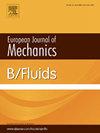Modeling of tuned liquid dampers with paddles: Hydrodynamic effects and estimation
IF 2.5
3区 工程技术
Q2 MECHANICS
引用次数: 0
Abstract
The hydrodynamic coefficients of internal damping devices, including drag coefficient Cd and inertia coefficient Cm, are crucial parameters affecting the damping and frequency design of the tuned liquid damper (TLD). However, studies on their variation laws are few. This paper presents an approach for estimating paddle hydrodynamic coefficients under harmonic excitation. An equivalent mechanical model (EMM) of the TLD, incorporating Cd and Cm of the paddles, is developed using potential flow theory. The computational fluid dynamics (CFD) method is employed to obtain the TLD’s steady-state response. The discrepancy between the EMM and CFD model responses is then utilized as the objective function and optimized using an improved Archimedes algorithm to determine Cd and Cm. On the basis of the above, a comprehensive parameter analysis is conducted for the TLD with paddles, and the effects of paddle dimension, water depth, and harmonic excitation amplitude on Cd and Cm are examined. Two new dimensionless parameters are introduced based on the Keulegan–Carpenter (KC) number to obtain the empirical formulas for Cd and Cm with superior fitting accuracy. The findings demonstrate that the wave height and base shear force predicted by the EMM generally agree with the CFD results. Compared with the previous constant Cm (Cm = 1), the proposed nonlinear empirical formula for Cm exhibits better accuracy in predicting paddle force and natural sloshing frequency shift generated by the paddles.
带桨的调谐液体阻尼器的建模:水动力效应和估计
内阻尼装置的水动力系数,包括阻力系数Cd和惯性系数Cm,是影响调谐液体阻尼器阻尼和频率设计的关键参数。然而,对其变化规律的研究却很少。本文提出了一种估计谐波激励下桨叶水动力系数的方法。利用势流理论建立了考虑桨面Cd和Cm的TLD等效力学模型。采用计算流体力学(CFD)方法获得了TLD的稳态响应。然后将EMM和CFD模型响应之间的差异作为目标函数,并使用改进的阿基米德算法进行优化,以确定Cd和Cm。在此基础上,对带有桨叶的TLD进行了综合参数分析,考察了桨叶尺寸、水深、谐波激励幅值对Cd和Cm的影响。基于Keulegan-Carpenter (KC)数引入了两个新的无量纲参数,得到了具有较好拟合精度的Cd和Cm的经验公式。结果表明,EMM预测的波高和基底剪切力与CFD计算结果基本吻合。与之前的常数Cm (Cm = 1)相比,本文提出的Cm非线性经验公式在预测桨叶力和桨叶产生的自然晃动频移方面具有更好的准确性。
本文章由计算机程序翻译,如有差异,请以英文原文为准。
求助全文
约1分钟内获得全文
求助全文
来源期刊
CiteScore
5.90
自引率
3.80%
发文量
127
审稿时长
58 days
期刊介绍:
The European Journal of Mechanics - B/Fluids publishes papers in all fields of fluid mechanics. Although investigations in well-established areas are within the scope of the journal, recent developments and innovative ideas are particularly welcome. Theoretical, computational and experimental papers are equally welcome. Mathematical methods, be they deterministic or stochastic, analytical or numerical, will be accepted provided they serve to clarify some identifiable problems in fluid mechanics, and provided the significance of results is explained. Similarly, experimental papers must add physical insight in to the understanding of fluid mechanics.

 求助内容:
求助内容: 应助结果提醒方式:
应助结果提醒方式:


